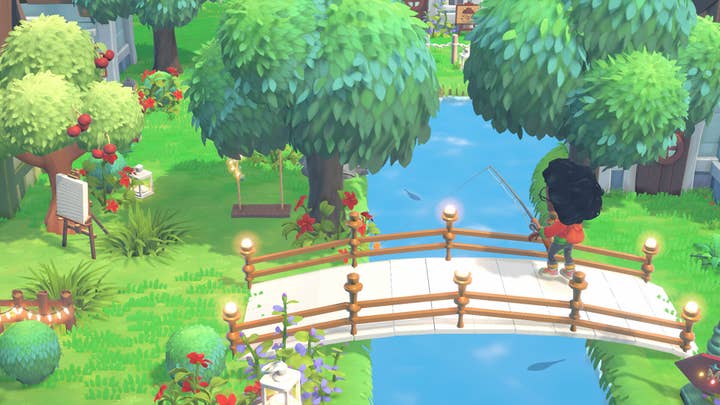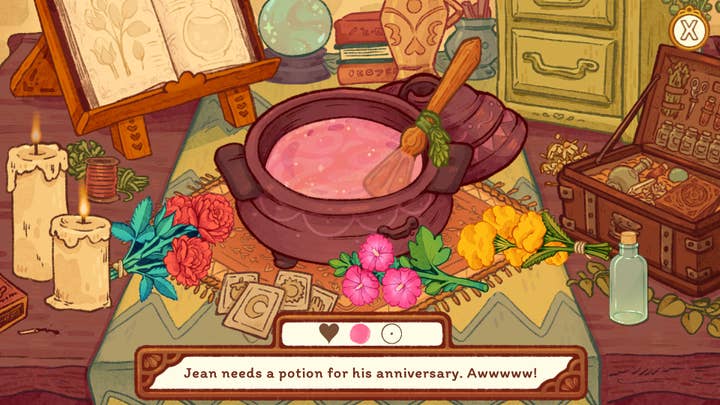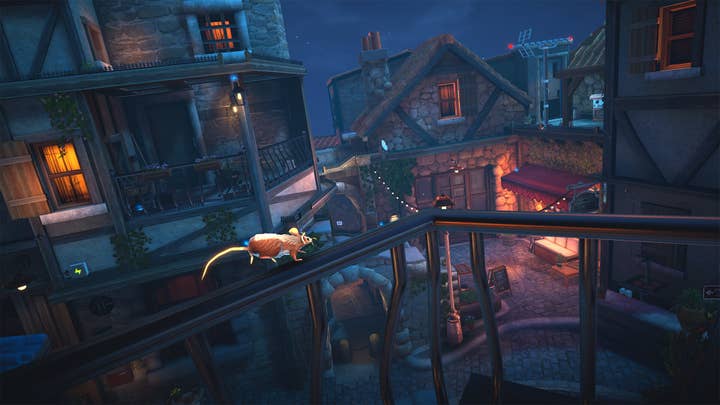What are cozy games, and what makes them cozy?
A trio of developers of recent wholesome games share lessons and discuss what players expect from the genre
Cozy games are nothing new, but their recent flourishing – and the increased desire of developers to broaden the genre – invites questions. What exactly is a cozy game? And is this subgenre a cul-de-sac, or a highway?
Some developers view these games as offshoots of the life-sim genre, which goes back to at least 1985's Little Computer People, before an explosion via The Sims (2000). But cozy games are generally regarded as featuring cute characters, often anthropomorphic animals or child-like humans, who engage in player activities such as farming, gathering, growing and nurturing, with a vague goal of creative personalization and in-game socialization.
But coziness is broader than farming and village-planning. The essential nature of cozy gaming is that of helping other people through non-violent means, often by nurture and generosity. Self-expression is core to the games' progression goals, which tend to be open-ended.
"People get depressed, and they need to relax. This has always existed in gaming, but it was a less marketable idea in the past"
Alexandre Stroukoff, Alblune
Socialization with NPCs or with other humans is important, and it's almost always of an agreeable nature. In cozy games, it's best to be nice. NPCs who are disagreeable in some way are usually played for comic effect. Aesthetics are usually (though not always) colorful or pastel-hued. Jolly, nursery-ish music tends to roll in the background. Peril is almost non-existent.
Such games have been with us since at least Natsume's Harvest Moon (1996) followed by the first of Nintendo's Animal Crossing games (2001). Indie hit Stardew Valley arrived on PC in 2016, and has since been ported to all major platforms, while being expanded enormously.
The recently intense popularity of cozy games is generally dated to the release of Nintendo's Animal Crossing: New Horizons, which swept through the world at exactly the same time as global pandemic lockdowns, becoming one of the most popular games of all time.
Nintendo Switch remains a favored platform for those consumers inclined towards cozy, wholesome games. On PC, Steam now lists dozens of games under its "cozy" rubric, only a handful of which were released prior to 2020. Dozens more are listed as "coming soon."
Speaking to three developers who have recently released cozy games, it's clear that there is a general desire to both map and replicate the essential features of coziness, while innovating enough to stand out in an increasingly crowded field.

Cozy gaming's essential vibes
All the developers we spoke to agreed that cozy games are best defined by how they make you feel, rather than via mechanics or looks.
It's certainly true that few other genres are named for a feeling – "first-person shooter" and "turn-based strategy" are not feelings. Cozy certainly is, and cozy is always a good feeling, evoking cuddles on the couch with pets, children and significant others.
Robert Tatnell is the solo developer of the recently released Hokko Life, available on PC, and inspired by Animal Crossing. He says: "Coziness is the understanding that humans are social creatures. We strive to be part of a group, and to be accepted. But being sociable can be difficult in the real world. It can be exhausting. In cozy games, the barriers come down. We can be part of a group without having to be stressed. The characters we meet are warm and welcoming and it's an easier way to enjoy a fundamentally human feeling."
Luka Lescuyer is a co-founder at Montreal-based Alblune, which recently released The Spirit and the Mouse. It's an exploration game in which a mouse does favors for people. He says he's comfortable with the label "cozy", so long as it doesn't limit the genre's potential.

"People need a label right now so they can understand that the game is different," he says. "It's non-violent. But the label may disappear in a few years because it will become normal for everyone to play those types of games."
Joint co-founder Alexandre Stroukoff adds: "People get depressed, and they need to relax. This has always existed in gaming, but it was a less marketable idea in the past. Now, we recognize that it's an important part of playing games."
Allie Ast is founder and creative director of Sundew Studios, which recently released Witchy Life Story, a game about crafting potions and spells.
"I spend a lot of time on Instagram with communities that love and celebrate cozy games," she says. "Sometimes it's surprising to find the kind of games that they celebrate.
"The latest Zelda game [Breath of the Wild] has combat in it, but people love the sense of exploration and just being in that world. Sometimes I see players talk about those same elements in Skyrim. In both cases you spend a lot of time roaming around and enjoying the scenery, meeting people, crafting, and that's the feeling that cozy games give us, despite the combat."
The challenge of non-violence
Creating games in which problem-resolution eschews violence is not as easy as it sounds. The Spirit and the Mouse mainly involves exploration, item collection, and puzzle-solving.
"Shooting and killing things is ingrained into games as a standard visceral feedback and progress mechanic," says Stroukoff. "Non-violence was our biggest design challenge. When you cannot rely on violence to make it interesting, you have to find new ideas, but that was the kind of game we wanted to make."
"When you turn away from [combat], you have to find a greater variety of ways to constantly engage players, and that's not easy"
Luka Lescuyer, Alblune
Lescuyer says that picking a non-threatening animal protagonist – a mouse – was a deliberate decision.
"Killing enemies is the basic stuff that keeps people engaged in a lot of games. When you decide to turn away from that, you have to find a greater variety of ways to constantly engage players, and that's not easy."
Likewise, cozy games tend to upend the standard psychological prompt of impending failure, in which peril is a near constant.
Tatnell tells a story about an important lesson he learned about cozy game design: "When I was designing Hokko Life, I played around with the idea of the player having limited stamina which needed to be replenished. But it felt too stressful."
As a result, Tatnell abandoned this idea entirely. He adds, "Punishing the player by saying 'oh, you went too far' or 'you did too much'. That's not what cozy games are about, which is escaping stress triggers and relieving threats, peril and stress."

A genre targeting a gender?
Discussion of gender and cozy games can easily devolve into tired gender-essentialism. The limited patriarchal view of women scans closely with the profile of cozy games – nurturing, social, creative, and empathetic (a tangled knot that is far beyond the scope of this article.) A recent study showed marked genre-preferences between genders. Cozy games were not featured, but the two genres in which women made up a majority were casual and mobile.
Among developers, there's a general agreement that, while the cozy audience skews slightly towards women and girls, the genre's future demographic is unclear. For sure, plenty of men enjoy cozy games – Animal Crossing: New Horizons players gender-split was about even – but online fan communities tend to be majority women. This is rarely true of other definable genres outside the mobile and online-spheres.

Cozy games, like Animal Crossing, are sometimes marketed to women. Nintendo booked ads for the game in women's magazines like Vogue, which traditionally carry little in the way of video game advertising.
"I've seen this discourse come up, where broadly marginalized people are expected to create nice content," says Ast, who estimates that 90% of the cozy gaming online forums she attends are made up of women. "I would say cozy games fall into that."
She adds: "I did not specifically market Witchy Life Story towards women. But I can't control social media algorithms that pick up on their own cues. I would say that while cozy games are probably gendered now, that's more to do with some of the issues we're working through as a society."
Ast has played games all her life, and was a fan of "horsey" games as a girl. Cozy games, she says, are sometimes positioned as adult versions of those genres, and while that seems like a retrograde interpretation of women and games, "we've got to start somewhere," she says. In the past, almost zero games were marketed or made with adult women in mind.
In the end, coziness is something that we all enjoy. "Sometimes it's nice to have a break from playing Call of Duty, and spending some time in Stardew Valley," says Stroukoff. "A lot of people are comfortable making those jumps and playing a variety of games, depending on how they feel."
What cozy gamers want most of all
A repeated refrain among developers is that emotional resonance, pacing, and "vibe" are the most important features of a cozy game.
"Pacing is important, allowing the player to play at whatever pace they want," says Lescuyer. "You feel like you're inhabiting a nice place, like you're on vacation on a tropical island, and everyone is nice to you."

Ast says that, while designing Witchy Life Story, she spent a lot of time and effort speaking to cozy game fans and influencers online.
"The takeaways I often get is that, apart from a lack of violence, players want the freedom to do whatever they want. They see a world that they want to inhabit, and then they want as much freedom as possible, especially to be creative and sharing. Pastoral aesthetics and chill music help to establish that vibe."
For Tatnell, cozy vibes extend outwards from the games themselves.
"Players spend time in the game interacting with characters who are warm and welcoming, and that is also the sense I get from the community when they share their in-game creations. Giving players the tools to create stuff also allows them to gather and share and connect with one another."
He adds: "People sharing what they're doing in the game means that they are sparking ideas with each other."

The future of cozy games
It may be that the current rush of cozy games will come to be seen as a glut. But the satisfaction that such games offer players – and the genre's capacity to grow gaming as a whole – is here to stay.
Now, developers are looking for ways to deliver wholesome, non-violent fun, without rehashing the same 'gather-and-grow' mechanics. They are moving in fascinating new directions.
Adam Robinson-Yu's A Short Hike (2019) is a good example of a cozy game that's not about farming, but about open-world exploration. My Time at Portia is a classic farming game, but set in the aftermath of an apocalypse. Both Gris (Nomada Studio), and Spiritfarer (Thunder Lotus Games) are low peril, non-violent games that explore the problem of grief, with great sensitivity.
Witch Beam's much-admired Unpacking is a story about love and relationships, wrapped up in light home decoration / moving house puzzles. Islanders is a cute game that cozifies the SimCity urban planning model. Cozy Grove follows a similar model to Animal Crossing, but offers a spooky narrative.
Stardew Valley creator Eric Barone (aka ConcernedApe) is currently putting the finishing touches to Haunted Chocolatier. It has an eminently cozy profile – players run a chocolate shop – but the developer says he wants to "explore more fantastical possibilities" than in his previous work.
Stroukoff says: "You can feel a community of gamers that is growing, who aren't only interested in farming games, but want all kinds of games that help them relax, and that aren't violent. I think it will be cool when those kinds of games are no longer seen as being outliers but as central to gaming."
Ast adds: "If you're making one of these games, there's a pretty decent chance that social media influencers will reach out to you. They are looking for this type of content. I know there's a lot of these games right now, but it's not like there's 700 of them coming out every day."
Tatnell concludes: "There's definitely a dominant style [in cozy gaming]. But I've seen more and more games that are moving outside of that and pushing in new directions. The more saturated the market becomes, the more we'll see new ways to get to that welcoming, relaxed atmosphere that defines cozy games."
More GamesIndustry.biz Academy guides to Working in Games
Our guides to making games cover various aspects of the development process, whether you're a young game developer about to start a new project or an industry veteran:
